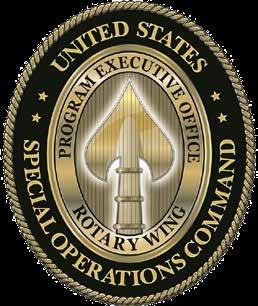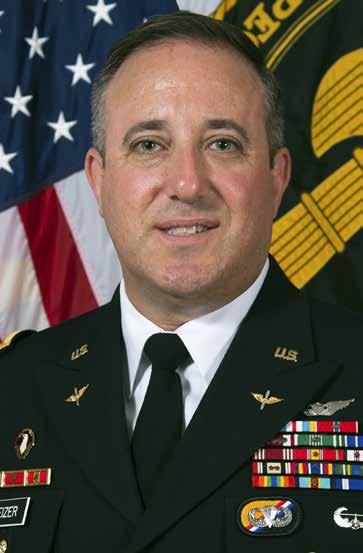
8 minute read
FORGING FUTURE CAPABILITIES FOR VERTICAL LIFT READINESS
FORGING FUTURE CAPABILITY FOR VERTICAL LIFT READINESS
COL Paul I. Weizer currently serves as the Program Executive Officer Rotary Wing Systems at U.S. Special Operations Command (USSOCOM) headquarters at MacDill Air Force Base. He recently served as the Director, Armaments Cooperation for the U.S. Mission to the North Atlantic Treaty Organization (NATO) in Brussels, Belgium and previously served as the board-selected Product Manager for Special Operations Forces Training Systems, Program Executive Office for Simulation, Training and Instrumentation in Orlando, Florida.
Advertisement
COL Weizer enlisted in the Army in 1990 and served as an Air Traffic Control Specialist for two years before accepting the “Green-toGold” scholarship to attend the Army ROTC program at the University of Tampa (Class of ‘94). He graduated with a Bachelor’s degree in Business Management and was commissioned as a second lieutenant in the Aviation branch. He completed the resident aviation basic and advanced officers’ training courses and has served as a platoon leader, executive officer, battalion logistician and company commander.
Upon completion of his tour as company commander, COL Weizer transitioned in the Army from aviation to material acquisition management. As an Acquisition Corps officer, he has served as an operational test officer, contract management officer, systems integration officer, assistant project manager, Department of the Army systems coordinator, theater acquisition advisor, product manager, and joint/interagency land armaments advisor. He has completed the University of Tampa MBA program (Class of ‘11) and the National Defense University’s Eisenhower School Master of Science in National Resource Management along with the Defense Acquisition University’s Senior Acquisition Course concentration (Class of ‘17).
Armor & Mobility spoke recently with COL Paul Weizer, PEO Rotary Wing Systems, USSOCOM, regarding some focus areas SOCOM is targeting for sustainment and advancement of critical Future Vertical Lift (FVL) capability so that it’s there when and where SOF operators need it.
A&M: As Future Vertical Lift (FVL) development continues, how is SOCOM helping shape SOF future vertical lift requirements?
COL Weizer: SOCOM has subject matter experts assigned to the various future vertical lift enterprise agencies, such as the Future Vertical Lift (FVL) Cross Functional Team, to ensure open communications between SOCOM and the Army. Also, SOCOM, working with Congress, has secured additional funding to ensure Special Operations Peculiar (SO-P) equities are engineered into the early designs of the competitive prototypes. Ideally, the production models of the future vertical lift aircraft will need minimal modifications post production to become SOF platforms.
COL Paul Weizer Program Executive Officer-Rotary Wing Systems U.S. Special Operations Command

vertical lift, how is SOCOM working to influence capability for SOF application?
COL Weizer: The Systems Integration Management Office (SIMO) of the Special Operations Aviation Command has been conducting experiments within the Future Long Range Assault Aircraft (FLRAA) lines of effort to assist the future vertical lift cross functional team in developing doctrine, tactics, techniques and procedures utilizing future technologies in support of multi-domain operations. This office provides risk reduction along the spectrum of capability technology maturation before it is inserted wholesale into the service-led program. SOCOM is also investing early into the design phase of the program to ensure SO-P equities get baked into the baseline platform.
A&M: From a future attack recon perspective, how is SOCOM looking to transition to future vertical lift from MH-6 Little Bird?
Since the unit is able to automatically determine the substrate and Aircraft program) develops into production aircraft. SOCOM will work hard to ensure SO-P equities are engineered into the early FARA candidates, but it is too early to determine whether the mission(s) currently conducted by the A/MH-6 “Little Bird” are suited to be conducted by the production FARA platform. Ideally, some or all of the current “Little Bird” missions could/would be assumed by one or more of the future vertical lift platform variants.

The MH-6M Little Bird, seen here moving U.S. combat troops, remains an important SOF vertical lift platform with the continued evolution of Army Future Vertical Lift (FVL). (USSOCOM)
A&M: In terms of affordability, talk about ways SOCOM is achieving budget goals while addressing future vertical lift integration goals?
COL Weizer: SOCOM relies heavily on the Services to meet its budget goals. The more SOCOM can mainstream SO-P requirements, the less it must utilize its own limited budget to develop and deliver capability. PEO Rotary Wing systems utilize a variety of business initiatives and reforms to get the most capability to the SOF Warfighter for the least amount of investment. All of these efforts place mission accomplishment at the forefront of our planning and
ADVANCED AEROSPACE COATING
The aerospace industry needs accurate LZ990 Portable Coating Thickness Gauge (Kett) destructive testing on painting, plating, anodizing, coating thickness measurement whenever and organic coatings with accuracy up to 0.1 um. plating, anodizing, powder coating or other Such testing takes less than a second to display coatings are required. This is particularly the measurement. important when the coatings play a critical Because the key to providing accurate, role in preventing the corrosion or wear of repeatable measurements is the operator’s ability metal substrates. Properly applied coatings, to reliably make consistent contact between the with thickness measured in mils (.001 inch) or instrument and the test surface, the unit also microns (.001 mm) are crucial to avoid coating utilizes a spring-loaded probe to generate a breaches leading to corrosion of the underlying consistent contact pressure with the measured substrate. surface. This integrated probe also includes built
“Incorrect paint consistency can affect in edge guides to enable easy measurement drying times or eventual flaking of the paint film,” says John Bogart, of even curved and edged surfaces. To ensure device stability during Managing Director of Kett US, a manufacturer of a full range of measurement, the foot of the probe is also designed to provide a coating thickness testers. “Too little paint coating and you are left firm platform when placed onto the test piece. According to Bogart, a with cosmetic issues in opacity, and protective issues like corrosion, number of other design considerations in handheld coating thickness wear, and exposure.” gauges can also simplify measurement and improve versatility. In order
Until recently, conducting frequent laboratory-quality coating to improve accuracy and durability on the aerospace factory floor or in thickness tests throughout the manufacturing process or in the field the field, it is best for the unit to have no moving parts, other than the has been difficult. Traditionally, this required meticulous sampling probe. and preparation, as well as taking the sample to the lab for evaluation. Similarly, the unit should be impervious to vibration, with Although portable coating thickness gauges are not new, most fail measurement independent of its orientation. To save time during the to provide the accuracy, speed, or simplicity required for anyone to testing process, Bogart recommends utilizing a unit with a large screen conduct quick checks as needed on the production line or in the field. that enables the quick reading of results. Those results should be able Fortunately, handheld devices are now available that allow personnel to to be stored in the gauge and transferred to a computer and/or printer easily and quickly perform lab-quality coating thickness measurements. for documentation and averaging purposes. An instrument that stores
In response, aerospace industry innovators have developed a many test measurements is best so operators can perform numerous number of advanced designs for handheld coating thickness test tests before downloading the results. devices. One example is Kett’s LZ990 portable coating thickness gauge “Easier, more accurate aerospace coating and plating measurement which combines two of the most widely used measurement methods, with handheld units will help to improve quality checks wherever magnetic inductance and eddy current, in a dual mode device that can needed,” added Bogart. “So, defects can be immediately detected and measure the coating thickness of almost any non-magnetic coating on corrective action undertaken to minimize scrap and faulty components both ferrous (magnetic) and non-ferrous (non-magnetic) substrates. or aircraft.” execution of SOF materiel development and delivery. use the appropriate measurement circuit, this enables instant, nonMore info: kett.com

INDUSTRY PERSPECTIVE
MAXIMIZING COMMS CAPABILITY SUPPORT Icom America, supplier of tactical communication products, introduces the first ever ATAK Plug-in family of radios: the F3400D/F4400D, F7010 (P25), SAT100, Dark Wolf Ventures SATCOM back haul device. By Glenn Williams, Federal Solutions Manager, Icom America
Dark wolf Backhaul over Iridium® using Icom SAT100.

The F3400D/F4400D is either a UHF/VHF 5-watt radio that will handle messaging and PLI. The F7010 radio is our P25 radio (smallest P25 radio on the market) that will also do PLI and messaging. The SAT100, connected to the Iridium® satellite network, will also plug into ATAK allowing for PLI to show up on the map. The Dark Wolf Ventures back haul device will allow the PLI from the UHF/VHF radios to be back hauled to other locations in the world as long as you have the SAT100 connected via the Dark Wolf Ventures device, and cable and a connection with Iridium®. An Android tablet or phone can be either connected via Bluetooth® or a new smart PTT that was developed in conjunction with DEM Manufacturing (currently the SAT100 must be Bluetooth® only). This product will work either as a plug into ATAK (Mil or CIV version). Icom SAT100 Icom F3400DS Icom F7010
SITUATIONAL AWARENESS
You can also use Icom America’s own stand-alone App called MMRIS developed in conjunction with Kopis Mobile. We are excited about our new ATAK plug-in product line. We plan to continue to add to this product line moving forward as our next update will be messaging and PLI over the P25 network, SAT100M (new mobile SAT PTT) as well as a new window 10 App. Something to look forward to coming out this fall.
Icom America Inc. believes this is a game changer with devices for an array of applications and happy to be part of the big picture with ATAK. Please keep your eyes open for new Icom products as we continue to move forward.
More info: icomamerica.com
ATAK Plug-in
Icom's COA Common Operational Awareness Situational Application
• Common operational picture • Integrates seamlessly into ATAK • Real time S/A (Situational Awareness) • AES Encryption • Compatible with Icom’s F3400D / F4400D Series – proven radios by the US Military





